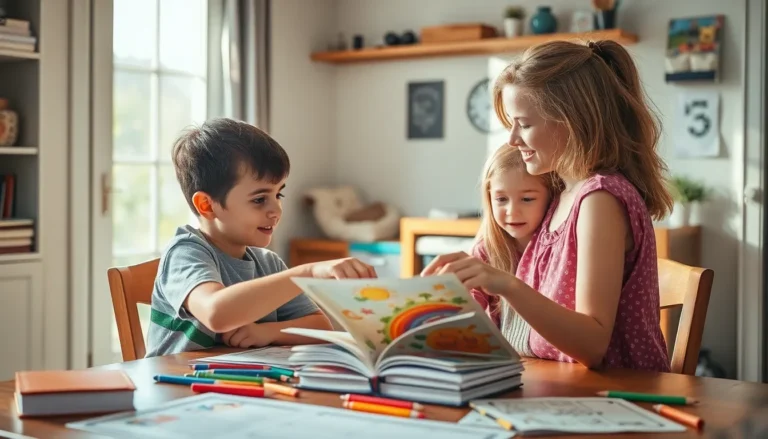Table of Contents
ToggleBlended families can feel like a sitcom where everyone’s trying to find their place in a chaotic script. With each parent bringing their unique style to the table, navigating these dynamics can be as tricky as assembling IKEA furniture without the instructions. But fear not! Embracing different parenting styles doesn’t have to lead to drama worthy of a reality TV show.
Instead of letting clashing approaches create tension, it’s time to turn those differences into a recipe for success. By understanding and respecting each other’s methods, families can blend their parenting styles into a harmonious mix. So grab your popcorn and get ready to learn how to tackle the challenges of a blended family with laughter and love.
Understanding Blended Families
Blended families consist of at least one partner with children from previous relationships. These unique family structures require understanding and adaptability to thrive.
Definition and Dynamics
Blended families combine various elements, such as stepparents, stepsiblings, and biological parents. Each member brings distinct backgrounds and experiences. Communication plays a key role in managing these differences and fostering connections. Understanding each other’s perspectives helps build strong relationships among all family members. Everyone must recognize the importance of cooperation and support in creating a harmonious environment.
Challenges Faced
Navigating differing parenting styles presents a common challenge in blended families. Conflicts may arise when parents’ approaches clash, affecting children’s stability and security. Establishing authority can become complicated, especially when children hold loyalty to their biological parents. Additionally, establishing routines and traditions may create friction if preferences differ. Each partner’s previous experiences can also impact their expectations and behaviors. Creating a unified front proves essential in overcoming challenges and promoting family unity.
Identifying Parenting Styles
Understanding parenting styles is crucial for managing a blended family’s dynamics. Each style impacts children’s behavior, relationships, and emotional development. Recognizing these approaches leads to more harmonious family interactions.
Authoritative Parenting
Authoritative parenting combines warmth and structure. Parents set clear rules while encouraging independence. They prioritize open communication, allowing children to express themselves. Children raised in this environment typically exhibit high self-esteem and social competence. Blended families benefit from this approach, fostering mutual respect and understanding among all members.
Authoritarian Parenting
Authoritarian parenting emphasizes strict discipline and high expectations. Parents enforce rules with little room for dialogue or flexibility. This style often stifles children’s independence and creativity. Children may comply out of fear rather than respect, leading to resentment. Blended families might experience heightened conflict if one partner adopts this approach, impacting overall family harmony.
Permissive Parenting
Permissive parenting is characterized by leniency and minimal expectations. Parents act more like friends than authority figures. While this approach promotes creativity, it might hinder children’s ability to understand boundaries. In a blended family, contrasting permissive styles can create confusion in children, complicating efforts to establish consistent guidelines.
Uninvolved Parenting
Uninvolved parenting reflects a lack of emotional and physical engagement. Parents provide basic needs but fail to offer guidance or support. Children often struggle with emotional regulation and attachment issues. This style can create significant challenges in a blended family, where existing relationships demand attention and nurturing to thrive.
Strategies to Deal with Different Parenting Styles
Navigating diverse parenting styles in a blended family requires strategic approaches that promote harmony and understanding.
Open Communication
Effective communication remains essential in blended family dynamics. Families benefit from openly discussing individual parenting philosophies, including expectations and concerns. Encouraging honest dialogue creates an environment where all voices are heard, minimizing misunderstandings. Sharing experiences allows parents to connect and strategize together, strengthening the family unit. Children observe these interactions, learning the value of communication, which fosters respect and trust.
Establishing Common Goals
Setting unified family goals aids in aligning different parenting styles. Parents can collaboratively define the desired outcomes for their children, such as academic success or emotional resilience. When families share common aspirations, they establish a coherent approach to parenting. This alignment ensures that children receive consistent messages, reducing confusion. Prioritizing shared values encourages cooperation among parents, enhancing family cohesion and stability.
Setting Boundaries and Consistency
Clear boundaries provide structure within blended families. Parents should work together to establish rules that reflect their combined parenting styles. Consistency in enforcing boundaries ensures children understand expectations, leading to fewer conflicts. Discussing any adjustments needed quickly addresses potential issues. This teamwork not only strengthens parental authority but also gives children a secure foundation, helping them feel safe and supported.
Role of Stepparents
Stepparents play a vital role in blended families, influencing relationships and overall family dynamics significantly.
Building Relationships with Stepchildren
Building relationships with stepchildren requires patience and understanding. Stepparents can create a bond through shared interests, such as hobbies or activities. Open conversations about feelings foster connection and trust. Joining family outings helps integrate stepparents naturally into the family unit. Listening to stepchildren’s concerns shows care and validates their emotions. Participating in family traditions can bridge gaps and create shared experiences. Seeking opportunities for one-on-one time allows for deeper connections. Demonstrating consistency in behavior reassures children of their intentions. Celebrating milestones and achievements together promotes a sense of belonging. Stepparents become part of the family narrative when they involve themselves in everyday life.
Navigating Conflicts with Biological Parents
Navigating conflicts with biological parents requires diplomacy and respect. Maintaining open lines of communication minimizes misunderstandings. Establishing a united front for children strengthens family bonds. Respecting the biological parent’s role cultivates a cooperative atmosphere. Discussions about parenting differences should remain constructive and solution-oriented. Finding common ground on key parenting issues creates stability for children. In cases of disagreement, focusing on the child’s best interests is essential. Setting boundaries helps protect relationships from tension. Collaborating on routines and decisions promotes family cohesiveness. Stepparents contribute positively when they prioritize collaboration and respect.
Seeking Professional Support
Professional support can enhance family dynamics within a blended family. Seeking help from experienced professionals often provides valuable guidance and resources for navigating different parenting styles.
Family Counseling Options
Counseling options offer tailored support for blended families. Professional counselors facilitate discussions about parenting challenges. They help family members express their feelings and explore options to improve communication. Sessions can focus on addressing conflicts and developing strategies for cooperation. Family counseling also enables families to understand and appreciate each member’s perspective, fostering a sense of unity. Engaging in counseling helps create a safe space for honest conversations, ultimately benefiting both parents and children.
Parenting Workshops
Parenting workshops provide practical tools and strategies for blended families. Attendees learn skills to manage diverse parenting styles effectively. Workshops often cover topics such as setting boundaries, encouraging cooperation, and enhancing communication. Facilitators may incorporate role-playing exercises that simulate real-life scenarios, allowing participants to practice new techniques. Many families find participating in these workshops strengthens their connections and promotes a shared understanding of parenting goals. Investing time in these resources equips families to tackle challenges together, boosting confidence and unity.
Blended families thrive on understanding and adaptability. By embracing diverse parenting styles and fostering open communication, families can create a nurturing environment for everyone involved. It’s essential to establish common goals and maintain consistency in rules to enhance unity and support children’s emotional development.
Stepparents play a crucial role in building connections and should approach relationships with patience and empathy. Seeking professional support through counseling or workshops can also provide valuable insights and strategies for navigating challenges. With commitment and cooperation, blended families can turn potential conflicts into opportunities for growth and connection.







